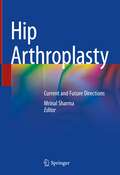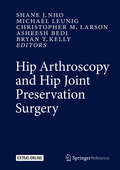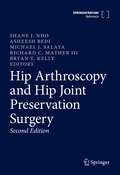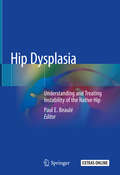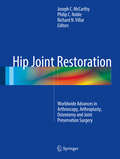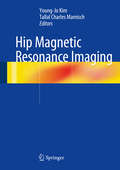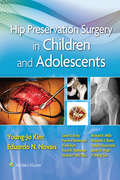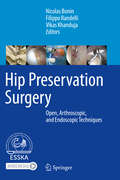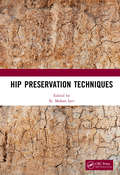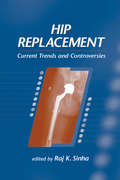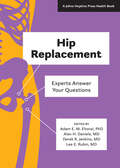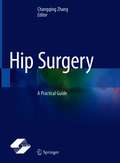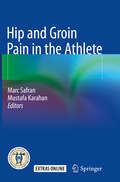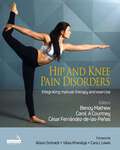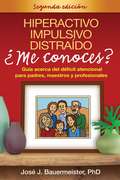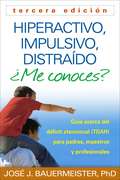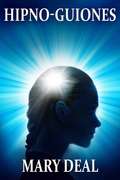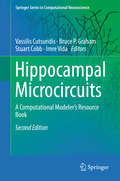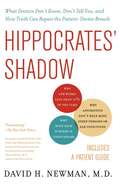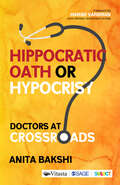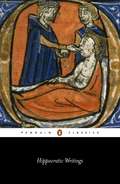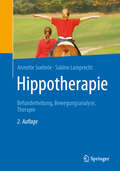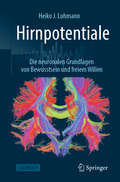- Table View
- List View
Hip Arthroplasty: Current and Future Directions
by Mrinal SharmaThis book brings together the latest updates and current trends in arthroplasty of the hip covering the basics as well as complex and revision surgery. Eminent arthroplasty surgeons across the globe have contributed to the chapters and shared their clinical experiences. There are separate sections on primary hip arthroplasty, complex scenarios requiring hip replacement, and detailed management of related complications. It covers revision hip replacement in detail with the latest updates on surgical techniques and implants. There are separate sections on computer navigation and robotic-assisted hip replacement surgeries. A special section on implants and tribology has been added. The language of the book is easy-to-read, user friendly with pictorial representation of relevant surgical steps. Case-based discussions, surgical tips, and summary has been added in each chapter. The references given at the end of each chapter would be useful for those doing research. This book is an essential on-the-desk book for practicing orthopedic surgeons across the globe, beginners in arthroplasty surgery, postgraduate students of orthopedics, DNB students, and those interested in research.
Hip Arthroscopy and Hip Joint Preservation Surgery
by Shane J. Nho Michael Leunig Christopher M. Larson Asheesh Bedi Bryan T. KellyHip pathology and nonarthritic hip conditions have only recently been recognized as a cause of hip pain. In 2003, Ganz, Leunig and colleagues described the concept of femoroacetabular impingement (FAI) as a cause of hip pain and a mechanism for end-stage hip osteoarthritis. Ganz et al. also postulated that 70-90% of hip osteoarthritis is likely due to abnormal hip mechanics related to FAI, dysplasia, or other hip deformities. Over the past ten years, the treatment of these non-arthritic hip pathologies has grown dramatically, and has been estimated to grow by 15% each year. It is the largest segment of grown in sports medicine and orthopedics as a whole. However, no definitive reference yet exists on hip arthroscopy and hip joint preservation surgery. While books have been published on hip arthroscopy, these texts are limited to the technical aspects of the procedure and do not explore content related to hip joint preservation surgery. The scope of this book covers the basic science of hip pathology, anatomy, biomechanics, pathology, and treatment. It has put together up-to-date research and has invited opinion leaders in the field to contribute to the text. The book is focused on disease pathology and provides comprehensive information on each disease topic, which is followed by technique-driven chapters to provide surgeons a reference for any procedure related to non-arthritic conditions of the hip. "
Hip Arthroscopy and Hip Joint Preservation Surgery
by Shane J. Nho Asheesh Bedi Bryan T. Kelly Michael J. Salata Richard C. MatherThe field of hip preservation surgery has evolved over the past decade as our understanding of hip pathomechanics and pathomorphology has expanded. The published literature on non-arthritic hip pathology, for example, has grown exponentially. The topics of controversy in the past decade have been answered in some cases, but new questions have also arisen. In addition to the 99 chapters in the original edition – most of which will be retained and updated as applicable – there will be over 30 brand new chapters focusing on new and more sophisticated techniques from authors that have been the pioneers of the field. The text is divided into nine thematic sections, covering the breadth of the topic and the current state of the art: basic science of the hip; operative basics for hip arthroscopy and open hip preservation surgery; pediatric hip conditions; approaches to disorders of the hip and pelvis; enthesopathy and neuromuscular disorders; hip fractures and instability; avascular necrosis; hip cartilage restoration; and oncologic conditions. Throughout, there is a heavy emphasis on surgical techniques, and video clips will be included in selected chapters. Written by edited by thought leaders and seasoned practitioners in the field, this new edition of Hip Arthroscopy and Hip Joint Preservation Surgery will remain the gold standard for orthopedic surgeons and sports medicine specialists, expanding on the range of techniques available to clinicians treating injuries to and disorders of the hip.
Hip Dysplasia: Understanding and Treating Instability of the Native Hip
by Paul E. BeauléThis book represents the most advanced understanding of diagnosis and management of hip dysplasia in the young adult, written by the world’s leading experts and covering advanced imaging and biomechanical studies as well as latest surgical techniques. This is especially timely, as the field of hip preservation surgery is in constant evolution, and it is critical that surgeons and researchers combine their efforts to provide the best evidence-based knowledge to all health care providers evaluating and treating patients suffering from pre-arthritic hip pain. Not only does this book discuss the most up-to-date information on the etiology and natural history of hip dysplasia, as well as pathomechanics and traditional and advanced imaging, it also presents new conceptions of its classification and subsequent management. The focus throughout the book is that hip dysplasia is a problem of instability, where both the bony structure and the soft tissue envelope (i.e., capsule, ligaments and muscles) are at play. Moreover, although corrective osteotomies such as the peri-acetabular osteotomy will remain the dominant treatment option, non-surgical treatments as well as hip arthroscopy are now being increasingly recognized as useful adjuncts in order for our patients to return to their desired activities. Finally, as the longevity of joint replacement surgery has improved dramatically, this should be strongly considered in cases where the outcome of joint preserving surgery is not as predictable. Orthopedic surgeons, sports medicine physicians, physiatrists and physiotherapists alike will find this book a valuable resource when treating the young adult with symptomatic hip dysplasia.
Hip Joint Restoration
by Joseph C. Mccarthy Philip C. Noble Richard N. VillarHip Joint Restoration is a comprehensive yet practical guide to the basic science and clinical applications of arthroscopy, arthroplasty, osteotomy and preservation surgery for the treatment of diseases and conditions of the hip. This generously illustrated text offers a comprehensive introduction to essential features of hip evaluation, the medical management of hip procedures, and treatment of specific conditions, and covers practical topics such as surgical anatomy of the hip, surgical approaches, instrumentation, and indications for arthroscopy and other surgical procedures aimed at restoration of the hip joint. Additional chapters cover clinical outcomes and equality of life following hip surgery, the current state of research and education of arthroscopic hip procedures throughout the world, other topics such as complications and rehabilitation in different patient populations. This book will be a useful resource for Orthopedic Surgeons and Osteopaths who perform open and arthroscopic hip preservation and total joint replacement, as well as for orthopedic residents and researchers.
Hip Magnetic Resonance Imaging
by Young-Jo Kim Tallal Charles MamischHip Magnetic Resonance Imaging presents a basic yet comprehensive discussion of the role and use of MRI in the diagnosis and treatment of injuries and diseases of the hip, highlighting common concerns and procedures. Beginning with the principles of MRI and dGEMRIC and moving on to normal and abnormal hip anatomy, the focus shifts to the MRI techniques used in the detection of disease conditions of the hip, including labral disease, osteonecrosis, extra-articular conditions and cartilage damage. Chapters on the utilization of biochemical imaging biomarkers in the treatment of hip disorders round out the text. Written by experts in radiology and orthopedics and generously illustrated with MRI radiographs, this book will be an important reference work for clinicians in those fields, as well as practitioners of sports medicine and primary care physicians.
Hip Preservation Surgery in Children and Adolescents
by Young-Jo Kim Eduardo NovaisThe first comprehensive reference in this important area of pediatric orthopaedics, Hip Preservation Surgery in Children and Adolescents, provides authoritative, highly illustrated guidance. Dr. Young-Jo Kim and his team at Boston Children’s Hospital are pioneers in the development of hip preservation techniques in children and adolescents with hip abnormalities and hip pain. This outstanding author team provides the information you need to avoid both osteoarthritis and hip replacement in this vulnerable patient population.
Hip Preservation Surgery: Open, Arthroscopic, and Endoscopic Techniques
by Nicolas Bonin Filippo Randelli Vikas KhandujaThis book offers practical guidance on all procedures that may be performed within the field of hip preservation surgery, arthroscopy, and endoscopy. European experts share their experiences on everything from basic injections to the most challenging hip procedures, offering step-by-step tutorials and highlighting important tips and tricks. Whereas most books on hip arthroscopy and hip preservation surgery concentrate on pathologies, surgical indications, and the basics of the treatment, here the focus is very much on the individual techniques and recognized variants. These techniques are clearly and precisely described with the aid of a wealth of photo and video illustrations. The coverage encompasses procedures applicable in the widest range of scenarios, including synovial pathologies, labral, chondral, and bony injuries, hip impingement, dysplasia and instability, snapping hips, gluteus medius and minimus tendonitis and tears, other tendinopathies, post-arthroplasty complications, and rehabilitation. The book is published in cooperation with ESSKA and will be an essential aid for orthopaedic surgeons at all levels of experience.
Hip Preservation Techniques
by K. Mohan IyerHip Preservation Techniques explores hip problems and presents and compares alternative protocols for treating the condition in children, adolescents, young adults, and adults. While poor long-term outcomes of arthroplasty have led to an increasing dependence on procedures to conserve the native hip, preservation surgery may maintain or protect a hip and prevent or delay the need for arthroplasty. Well-established techniques such as cartilage restoration and use of tissue-derived mesenchymal stem cells are presented, and conceptually different procedures such as Bernese peri-acetabular osteotomy, Salter’s and Pemberton’s osteotomy are also discussed. This book will be useful for medical students, residents and consultants with an interest in hip preservation surgery. Key Features Explores the emerging concepts in hip preservation surgery with a concise and to-the-point approach Discusses digital templating in total hip arthroplasty Examines the anterior approach to the hip for a minimally invasive prosthesis Offers a comprehensive coverage of the topic through beautiful illustrations
Hip Prosthesis: CAD Modeling, Finite Element Analysis (FEA) and Compressive Load Testing (SpringerBriefs in Applied Sciences and Technology)
by Solehuddin Shuib Najwa Syakirah Hamizan Amir Radzi Ab GhaniThis book highlights the critical challenge of improving the design and performance of hip implants, which are essential for enhancing patient outcomes in hip replacement surgeries. The book focuses on utilizing Finite Element Analysis (FEA) to optimize implant designs, ensuring they can withstand complex mechanical loads and reduce the risk of failure. It is hoped that readers will gain a deeper understanding of the significance of implant design and the role of FEA in predicting and enhancing implant performance, ultimately leading to better, more durable solutions in orthopedic surgeries.
Hip Replacement: Current Trends and Controversies
by Raj K. SinhaHip Replacement offers useful strategies to choose the appropriate biomaterials and implant structure avoid complications in hip replacement surgery analyze the bone-biomaterial interface perform difficult hip reconstructions track in vivo performance of hip prosthetics inhibi
Hip Replacement: Experts Answer Your Questions (A Johns Hopkins Press Health Book)
by Adam E. M. EltoraiA quick yet comprehensive guide for anyone considering hip replacement surgery.Each year, more than 300,000 adults in the United States undergo hip replacement surgery. What can the many people experiencing hip pain in this country expect before, during, and after surgery? Hip Replacement—part of a new series of Johns Hopkins University Press books on specific surgical procedures—is designed to provide quick answers to all of the most common questions individuals have about hip surgery and the recovery process. Focusing on the patient experience, this frank and easy-to-use book highlights real patient experiences with hip pain, diagnosis, and treatment. The book • discusses basic hip anatomy • describes the symptoms of hip arthritis • explores alternative treatments, including lifestyle changes, medications, and surgical treatments other than hip replacement • reviews the entire recovery process, including preferred exercises to help speed your recovery and how quickly you can return to certain activities• features a glossary of key terms and a list of frequently asked questions • contains numerous sidebars touching on important points to consider, questions to ask your doctor, red flags, and risks • is supplemented with useful illustrations and photographsThe book's concise format allows readers to peruse the content quickly in the days leading up to surgery and then refer to it during the recovery period. Written by experts in the field, Hip Replacement is destined to become the most trusted book on this topic. Contributors: Roy K. Aaron, MD, Valentin Antoci, Jr., MD, PhD, Travis Blood, MD, Eric Cohen, MD, Matthew E. Deren, MD, John Froehlich, MD, MBA, Derek R. Jenkins, MD, Dominic T. Kleinhenz, MD, Scott Ritterman, MD, Lee E. Rubin, MD
Hip Surgery: A Practical Guide
by Changqing ZhangThis book discusses disorders affecting the hip joint as well as its related structures, to help orthopedists develop an integrated way of thinking, and improve their decision-making strategies and treatment skills. The specific anatomy of the hip joint and the related structures provides vital motor functions. It also presents a challenge for orthopedists in terms of early diagnosis of disorders, which is essential for appropriate and effective treatment. The first part of the book provides a step-by-step introduction to intra-articular and abarticular hip disorders in both adults and children. It then describes the techniques and practicalities of managing various conditions in detail, presenting stereoscopic chromatic line drawings along with intraoperative illustrated figures. By demonstrating the regional anatomy, pathophysiology and related disorders in hip region, this book helps readers gain an understanding based on basic science and clinical research. It also offers instructive guidance to learners at different levels, including orthopedists, general practitioners and rehabilitation practitioners.
Hip and Groin Pain in the Athlete
by Mustafa Karahan Marc SafranThis book presents the latest knowledge in the evaluation and management of hip- and groin-related injuries in athletes. Techniques of hip arthroscopy, as well as their limitations and possible complications, are clearly described, and guidance is provided on the use of periarticular hip endoscopy in patients with periarticular problems. A series of chapters address the potential approaches in the various conditions that may be encountered in athletes, including femoroacetabular impingement, athletic pubalgia, chondral and labral injuries, and hip instability by world renowned experts in the field. Considerations in particular age groups, especially adolescents, are highlighted. Rehabilitation is discussed in detail, and a concluding chapter examines emerging perspectives on the management of hip injuries. The book is published in collaboration with ISAKOS and combines the international expertise of ISAKOS members renowned for their management of injuries to the hip and groin. Hip and Groin Pain in the Athlete will be a must-read for team physicians and all clinicians who treat athletes.
Hip and Knee Pain Disorders: An evidence-informed and clinical-based approach integrating manual therapy and exercise
by VariousHip and Knee Pain Disorders has been written to provide a state-of-the-art, evidence-informed and clinically-informed overview of the examination and conservative management of hip/knee pain conditions. Under the current predominantly evidence-based practice paradigm, clinician expertise, patient preference, and best available research determine examination, and prognostic and clinical management decisions. However, this paradigm has been understood by many to place greater value and emphasis on the research component, thereby devaluing the other two. Evidence-informed practice is a term that has been suggested to honor the original intent of evidence-based practice, while also acknowledging the value of clinician experience and expertise. In essence, evidence-informed practice combines clinical reasoning, based on current best evidence, with authority-based knowledge and a pathophysiological rationale derived from extrapolation of basic science knowledge. Unlike other published textbooks that overemphasize the research component in decision-making, this book aims to address the clinical reality of having to make decisions on the management of a patient with hip/knee pain, in the absence of a comprehensive scientific rationale, using other sources of knowledge. It offers an evidence-informed textbook that values equally research evidence, clinician expertise and patient preference.The book is edited by three recognised world leaders in clinical research into manual therapy and chronic pain. Their research activities are concentrated on the evidence-based management of musculoskeletal pain conditions using conservative interventions. For this book they have combined their knowledge and clinical expertise with that of 38 additional contributors, all specialists in the field The contributors include a mix of clinicians and clinician-researchers.Hip and Knee Pain Disorders is unique in bringing together manual therapies and exercise programs in a multimodal approach to the management of these pain conditions from both a clinical, but also evidence-based, perspective. It acknowledges the expanding direct access role of the physical therapy profession. The book provides an important reference source for clinicians of all professions interested in conservative management of the hip and knee regions. It will also be useful as a textbook for students at both entry and post-graduate level.
Hiperactivo, Impulsivo, Distraído ¿Me conoces?, Segunda edición
by José J. BauermeisterEscrita específicamente para los padres y los maestros de habla hispana, esta guía práctica y realista ofrece consejos esenciales para ayudar a los niños con el TDA o el TDAH. El destacado experto, Dr. José J. Bauermeister, extrae los conocimientos científicos más recientes sobre estos problemas y describe medidas claras que se pueden tomar para reforzar las habilidades de su niño, encontrar los tratamientos apropiados, promover el éxito escolar y mejorar su comportamiento tanto en la casa como en la escuela. A lo largo de su carrera, el Dr. Bauermeister se ha dedicado a trabajar con niños y familias hispanas, cuyas experiencias y cultura únicas están reflejadas en cada página. El contenido especial de esta edición incluye la información más actualizada sobre los medicamentos y cuándo (y cuándo no) se deben usar; el problema del TDAH en las niñas, frecuentemente pasado por alto; cómo explicar el trastorno a los niños; consejos para aumentar la autoestima, y mucho más. Written specifically for Spanish-speaking parents and teachers, this practical, down-to-earth resource offers essential guidance for helping children with ADD or ADHD. Leading expert Dr. José J. Bauermeister distills the latest scientific knowledge about these problems and describes clear steps you can take to build on your child's strengths, find the right treatments, promote school success, and improve behavior both at home and in school. Dr. Bauermeister has devoted his career to working with Hispanic children and families, whose unique experiences and culture are reflected on every page. Special features of this edition include the latest information on medications and when (and when not) to use them, the often-overlooked problem of ADHD in girls, how to explain the disorder to kids, tips to increase self-esteem, and much more.
Hiperactivo, Impulsivo, Distraído ¿Me conoces?, Tercera edición
by Russell A. Barkley José J. BauermeisterSi su hijo ha recibido un diagnóstico del trastorno por déficit de atención con hiperactividad (TDAH), usted necesita orientación y apoyo en los que pueda confiar. Ha llegado al lugar correcto. Uno de los principales expertos, el Dr. José J. Bauermeister, explica, con claridad, la naturaleza de los problemas de atención y las razones por las que los niños con estos trastornos actúan como lo hacen. Usted aprenderá estrategias cuya eficacia ha sido comprobada para superar los frustrantes problemas de la conducta, para ayudar a su hijo a tener éxito en la escuela y, de ser necesario, para encontrar la ayuda profesional adecuada. El Dr. Bauermeister ha dedicado su carrera a trabajar con niños hispanos y con familias hispanas cuyas experiencias y culturas distintivas se reflejan en cada página. Escrito en español (no traducido), este libro es un recurso único para ayudarlo(a) a usted a satisfacer las necesidades de su hijo. Además, proporciona información esencial para maestros y otros profesionales. Esta tercera edición, revisada y actualizada, incluye la investigación científica y las estrategias de tratamiento más recientes. If your child has been diagnosed with attention-deficit/hyperactivity disorder (ADHD), you need guidance and support that you can trust. You've come to the right place. Leading expert Dr. José J. Bauermeister clearly explains the nature of attention problems and why children with these disorders act the way they do. You'll learn proven strategies for overcoming frustrating behavior problems, helping your son or daughter succeed in school, and, if needed, finding the right professional help. Dr. Bauermeister has devoted his career to working with Hispanic children and families, whose unique experiences and culture are reflected on every page. Written in Spanish (not a translation), this is a unique resource to help you meet the needs of your child. It also provides essential information for teachers and other professionals. Revised and updated, the third edition includes the latest scientific research and treatment strategies.
Hipno-Guiones: Técnicas que cambian la vida utilizando la autohipnosis y la meditación
by Mary Deal¿Le gustaría tener el poder de convertirse en todo lo que puede ser? Toda programación bien intencionada funciona mejor cuando alcanza un estado mental más profundo. El secreto está en acceder a esos estados a través de técnicas fáciles que cambian la vida. Una delgada ventana de conciencia diferencia dos estados de la mente: autohipnosis y meditación, y este libro mostrará sus similitudes y definirá cada condición y accesibilidad. Si tiene la curiosidad de al menos leer detenidamente este libro, entonces la capacidad de aprender estas técnicas ya es parte de su conciencia y pronto será reconocida. ¡Es afortunado! Su subconsciente lo incita a investigar. Está diciendo que es capaz de tener estados mentales más profundos. Muchos han tratado de concentrarse para aprender la autohipnosis o la meditación y han fallado. La concentración aplicada y saber qué esperar una vez cautivado puede ser lo que faltaba. Las instrucciones en este libro están destinadas a aquellos que deseen aprender y usar las técnicas de autohipnosis y/o meditación para la superación personal. Se proporcionan guiones fáciles pero potentes para producir los cambios deseados. Puede cambiar su vida hoy.
Hippocampal Microcircuits: A Computational Modeler's Resource Book (Springer Series in Computational Neuroscience #5)
by Vassilis Cutsuridis Bruce P. Graham Stuart Cobb Imre VidaThis is the 2nd edition of a very well received and popular book that reflects the current state-of-the-art of the ongoing research avenues concerning the hippocampus and processing units bridging the gap between single cell activity, network activity and global brain function. It aims to provide a methodology to anyone interested in developing microcircuit level models of the hippocampus. <P><P> The book is divided into two thematic areas: (I) Experimental background and (II) Computational analysis. In part I, leading experimental neuroscientists discuss the morphological, physiological and molecular characteristics as well as the connectivity and synaptic properties of the various cell types found in the hippocampus. Behaviour-related ensemble activity patterns of morphologically identified neurons in anesthetized and freely moving animals provide insights on the function of the hippocampal areas. In part II, computational neuroscientists present models of the hippocampal microcircuits at various levels of detail (e.g. single cell level, network level, etc.). Synaptomics and connectomics models of hippocampal structures are initially discussed. Then, network models of memory, rhythm generation and spatial navigation are presented, followed by abstract and biophysical models of synaptic plasticity. Network models of hippocampal implicated disorders (epilepsy and schizophrenia) are then detailed and how their network topologies, connectivities and activities change in these diseases. Finally, two chapters are dedicated to describing simulator environments of single neurons and networks currently used by computational neuroscientists in developing their models and modelling tools to parametrically constrain them. <P><P> This engaging volume is invaluable to experimental and computational neuroscientists, electrical engineers, physicists, mathematicians and others interested in developing microcircuit models of the hippocampus. Graduate level students and trainees in all of these fields can find this book a significant source of information.
Hippocrates' Shadow
by David H NewmanEveryone knows of the Hippocratic Oath, the famous invocation sworn by all neophyte physicians. But most don't realize that the father of modern medicine was an avid listener and a constant bedside presence. Hippocrates believed in the doctor-patient connection and gained worldwide renown for championing science over mysticism while respecting and advocating the potency of human healing. Today, argues Dr. David H. Newman, medicine focuses narrowly on the rewards of technology and science, exaggerating their benefits and ignoring or minimizing their perils. Dr. Newman sees a disconnect between doctor and patient, a disregard for the healing power of the bond, and, ultimately, a disconnect between doctors and their Oath. The root of this divergence, writes Dr. Newman, lies in the patterns of secrecy and habit that characterize the "House of Medicine," modern medicine's entrenched and carefully protected subculture. In reflexive, often unconscious defense of this subculture, doctors and patients guard medical authority, cling to tradition, and yield to demands that they do something or prescribe something. The result is a biomedical culture that routinely engages in unnecessary and inefficient practices, and leaves both patient and doctor dissatisfied. While demonstrating an abiding respect for, and a deep understanding of, the import of modern science, Dr. Newman reviews research that refutes common and accepted medical wisdom. He cites studies that show how mammograms may cause more harm than good; why antibiotics for sore throats are virtually always unnecessary and therefore dangerous; how cough syrup is rarely more effective than a sugar pill; the power and paradox of the placebo effect; how statistics and studies themselves are frequently deceptive; and why CPR is violent, invasive -- and almost always futile. Through an engaging, deeply researched, and eloquent narrative laced with rich and riveting case studies, Newman cuts to the heart of what really works -- and doesn't -- in medicine and rebuilds the bridge between physicians and their patients.
Hippocratic Oath or Hypocrisy?: Doctors at Crossroads
by Anita Sikand BakshiMedicine was until recently a greatly respected profession supported by trust and faith on one side and compassion and care on the other. However, over the years, the relationship between doctors and patients has suffered. Doctors now find themselves in the news for all the wrong reasons. Labelled as ‘murderers’, ‘knife happy’, ‘organ stealing thieves’ or touts of pharmaceutical giants, they have now lost respect in the eyes of society. When and how did this happen? When did doctors go from being ‘Next to God’ to maut ke saudagar, as the media is so fond of labelling them? Hippocratic Oath or Hypocrisy?: Doctors at Crossroads is the author’s journey as a doctor over three decades, from a young medical student to an experienced paediatrician. She has used her experience to highlight serious issues—demanding patients, prescribing of unnecessary investigations, hospitals run like business houses, the role of big pharmaceutical industries and so on from the point of view of both doctors and patients. The author’s anecdotal style, which includes quotes from her many case studies, will keep the reader turning the pages eagerly till the end.
Hippocratic Writings
by HippocratesThis work is a sampling of the Hippocratic Corpus, a collection of ancient Greek medical works. At the beginning, and interspersed throughout, there are discussions on the philosophy of being a physician. There is a large section about how to treat limb fractures, and the section called The Nature of Man describes the physiological theories of the time. The book ends with a discussion of embryology and a brief anatomical description of the heart.
Hippotherapie: Befunderhebung, Bewegungsanalyse, Therapie
by Annette Soehnle Sabine LamprechtDieses Praxisbuch gibt einen umfassenden Überblick über Grundlagen, Durchführung und Indikationen dieser effektiven Therapieform. Die differenzierte Bewegungsanalyse von Mensch und Tier sowie deren Wechselwirkung zueinander stehen im Mittelpunkt und werden aus therapeutischer Sicht detailliert erörtert. Konkrete Fallbeispiele veranschaulichen den Komplex Pferd-Patient mit all seinen Facetten und schaffen das ideale Fundament für die spezifische praktische Anwendung.• Welchen Anforderungen müssen Pferd und Infrastruktur entsprechen?• Welche Patienten eignen sich zur hippotherapeutischen Behandlung?• Welche rechtlichen Rahmenbedingungen gilt es zu beachten?Finden Sie Antworten auf diese und viele weitere spannende Fragen und rüsten Sie sich optimal für diese hervorragende Therapieform mit dem Pferd.
Hirndoping & Co.: Die optimierte Gesellschaft
by Andreas G. FrankeLeistungssteigerung per Pille oder kurz „Hirndoping“ ist zu einem regelrechten Trend geworden, der innerhalb weniger Jahre besorgniserregende Ausmaße angenommen hat. Doch wie kommt das?Das Buch beleuchtet das brisante Thema „Hirndoping" erstmals aus zahlreichen Blickwinkeln wie Soziologie, Medizin, Sport- und Rechtswissenschaften und vielen weiteren Disziplinen.Es zeichnet den Weg von der Agrargesellschaft, in der die Geschwindigkeit des Lebens von den natürlichen Gegebenheiten abhing, bis in die heutige Zeit nach. Eine Zeit, in der es durch Globalisierung und Digitalisierung vermeintlich keine Grenzen mehr gibt. Die letzte Grenze, die es zu überwinden gilt, scheint unser Geist. „Hirndoping“ bietet sich hier als Antwort aus den Regalen der Arzneimittelindustrie an. Eine Antwort, die aber nur begrenzt funktioniert und die gesundheitlich, juristisch und ethisch nicht frei von Risiken und Nebenwirkungen ist. Alternativlos ist „Hirndoping“ jedenfalls nicht.
Hirnpotentiale: Die neuronalen Grundlagen von Bewusstsein und freiem Willen
by Heiko J. LuhmannDer Neurophysiologe Heiko Luhmann erforscht seit mehr als 35 Jahren die Funktionsweise von Nervenzellen und neuronalen Netzen. In diesem spannenden und provozierenden Buch informiert er Sie über die neuesten Erkenntnisse der Hirnforschung und wie diese unsere Vorstellungen über das Bewusstsein und den freien Willen verändern. Sie erfahren, dass die Trennung von Körper und Geist aus neurowissenschaftlicher Sicht nicht aufrechterhalten werden kann und wie unterschiedliche Wissenschaftsdisziplinen ein neues Konzept zur Funktionsweise unseres Gehirns entwickeln. Das Buch beschäftigt sich mit spannenden grundlegenden Fragen, wie:Warum gibt es überhaupt Gehirne? Wie kommt die Welt in den Kopf? Wie sind interne neuronale Karten aufgebaut? Wo ist das Bewusstsein lokalisiert und wie entsteht es? Hat der Oktopus ein Bewusstsein? Ist das Gehirn eine Prädiktionsmaschine? Erlaubt das Konzept der prädiktiven Kodierung einen freien Willen? Entwickeln wir mit Hilfe eines Hirn-Computer-Interfaces ein höheres Bewusstein? Sind wir technologisch in der Lage Gedanken zu lesen und zu erzeugen? Verfügen Roboter eines Tages über ein künstliches Bewusstsein?
